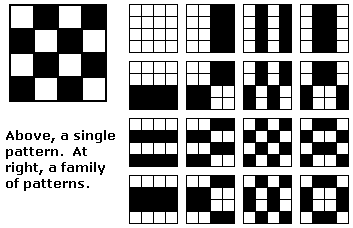
| Finite
Geometry Notes |
(Page created Oct. 2, 2005; last modified March 5, 2009.)
Some groups of transformations of square and rectangular arrays preserve interesting families of subsets of the arrays. Subsets in the preserved families may, for instance, be symmetric, even though the transformations are themselves asymmetric and discontinuous. Similarly for cubical arrays.| Geometry of the 4x4 Square | The Diamond 16 Puzzle |
| The Eightfold Cube | The Diamond Theorem |
| Diamond Theory | Notes on Finite Geometry |
Curtis, R. T., A new combinatorial approach to M24, Math. Proc. Camb. Phil. Soc. 79 (1976), pp. 25-42For details of how the Curtis model of the 759 octads is related to a group of 322,560 symmetry-preserving discontinuous transformations of a 4x4 array of square tiles, see Geometry of the 4x4 Square.

The above observations may contribute to the beginnings of such a theory. Clearly, letting a family of patterns generate a vector space under binary addition (i.e., symmetric difference of subsets) is a central strategy. What geometric properties of such vector spaces we may expect to emerge under group actions is, as the work of Curtis shows, not so clear. It seems that such a general theory of pattern-invariance might throw some additional light on such phenomena as the connection of the affine hyperplanes that underlie the diamond theorem with the Curtis model of the 759 octads (which includes versions of those affine hyperplanes).
Since n×n square patterns of black and white cells-- i.e., (0,1)-matrices-- are, essentially, binary relations on a finite set, such a theory would be rather closely related to the 1938 work of Marc Krasner on certain Galois connections:
From Ferdinand Börner, Martin
Goldstern, and Saharon Shelah,
Automorphisms
and strongly invariant relations (pdf),
a preprint dated Sept. 9, 2003
(Related material: A. Schleiermacher,
"Über einen Satz von Krasner,"
1.
Teil (pdf) and 2.
Teil (pdf))
See also Roger Duncan Maddux, Relation Algebras
(Elsevier, 2006).
Related material may be found by a Google search on,
say, "Galois connection" + "permutation group" + "relation."
Branko Grunbaum and G. C. Shephard,Grunbaum and Shephard say that
Tilings and Patterns, W. H. Freeman and Co.,
New York 1987
From: Robin Chapman
Subject: Re: Automorphism group of S_n
Date: Sun, 11 Feb 2001 10:26:17 GMT
Newsgroups: sci.math
In article <20010210221446.08836.00000412@ng-co1.news.gateway.net>,
jamesrheckman@gateway.netnospam (Jim Heckman) wrote:
>
> Yeah, I've seen that in a few places. Perhaps more to the OP's
> point is actually constructing Aut(S_6), which I've only seen done
> by laboriously exploring the detailed structure of S_6, or by
> making use of the (not obvious) isomorphism between A_6 and
> PSL(2,9) -- which requires knowing a lot about finite groups of
> Lie type. Is there a "simple" way to construct Aut(S_6), or at least
> to show that its order is 2*|S_6|?
The argument used to show that Aut(S_n) is usually S_n gives you that
Aut(S_6) has order |S_6| or 2|S_6|. So we have to find an automorphism
of S_6 not an inner automorphism. The classical approach is due to
Sylvester (or was it Cayley)?
S_6 acts on the numbers 1, 2, 3, 4, 5, 6. A duad is an unordered
pair of these numbers, eg 13 or 25. S_6 acts on these. A syntheme
is an unordered triple of disjoint duads e.g. 13/25/46. S_6 acts
on these too. A synthematic total is an unordered quintuple of
synthemes incorporating all 15 duads, e.g
13/25/46//14/26/35//12/34/56//15/24/36//16/23/45.
There are 15 duads, 15 synthemes and 6 synthematic totals.
Each permutation of S_6 gives rise to a permutation of the duads,
of the synthemes and of the synthematic totals. Labelling the
totals arbitrarily from 1 to 6 we see that each element of S_6 gives
rise to another via the permutation of the totals. Thus we get
a homomorphism from S_6 to S_6 which we see cannot be trivial.
But we can check
that a transposition (i j) permutes the totals without fixed points
so this automorphism is not linear.
The whole setup can be reversed. Each duad of totals corresponds to a
syntheme. Each syntheme of totals correponds to a duad and each
synthematic total of totals corresponds to a number. If we look at the
permutations of the set {numbers} u {totals} preverving the "structure"
we get a group of order 1440 having S_6 as a subgroup. This is
Aut(S_6).
-- Source:
http://www.math.niu.edu/~rusin/known-math/01_incoming/aut_S6
For related material, see "The alternating group of degree 6 in geometry of the Leech lattice and K3 Surfaces" (pdf) by Jonghae Keum, Keiji Oguiso, and De-Qi Zhang.
| From "Supercharacter Formulas for Pattern
Groups," by Persi Diaconis
and Nathaniel Thiem, preprint
of Oct. 4, 2006: Let Un(Fq) be the group of uppertriangular n × n matrices with entries in the finite field Fq, and with ones on the diagonal.... The primary focus of this paper is on a large class of subgroups called pattern subgroups. Let |
Page created October 2, 2005.